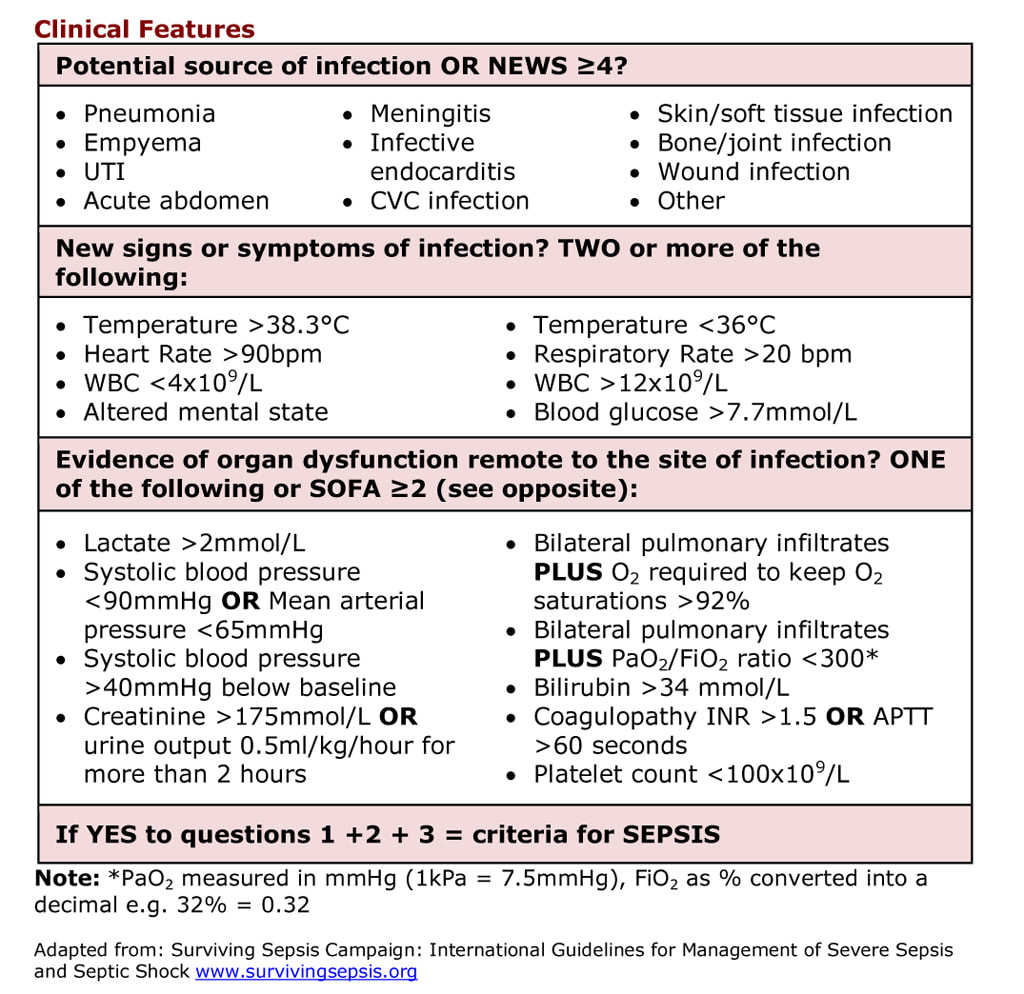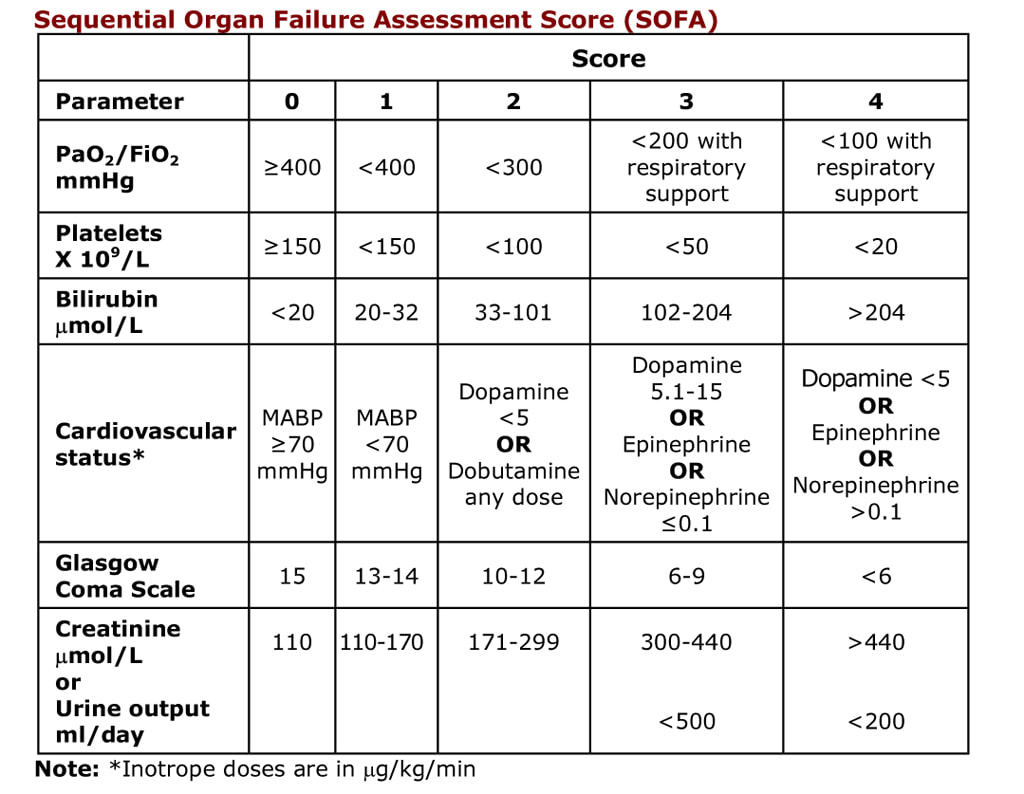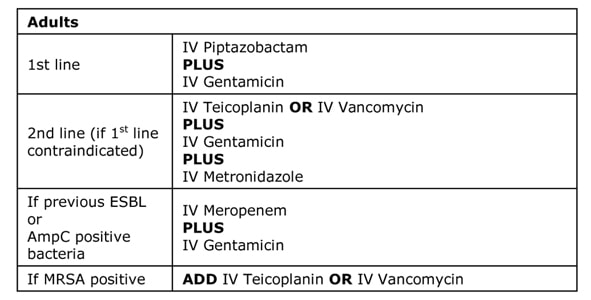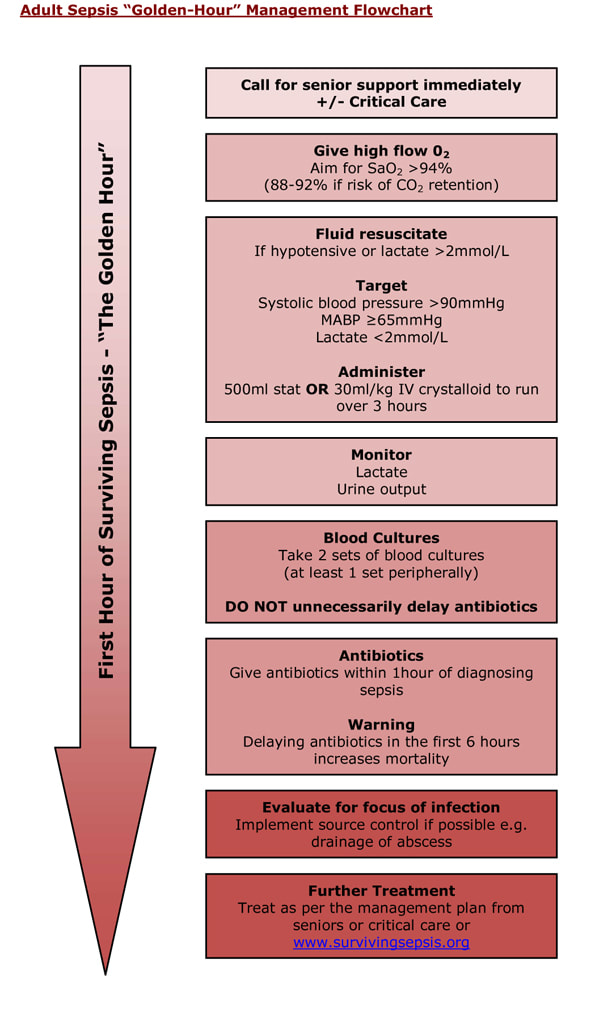Sepsis
Sepsis is defined as life-threatening organ dysfunction caused by a dysregulated host response to infection. Septic shock is sepsis with circulatory, cellular or metabolic dysfunction, and has a high mortality.
Sepsis and septic shock are clinical diagnoses not laboratory diagnoses:
Sepsis and septic shock are medical emergencies and early recognition and treatment improve survival.
Risk Factors for Sepsis
Sepsis and septic shock are clinical diagnoses not laboratory diagnoses:
- Sepsis - infection with evidence of a systemic response to that infection e.g. hypoxia, oliguria, confusion
- Septic shock - sepsis associated with organ dysfunction, hypoperfusion or hypotension
Sepsis and septic shock are medical emergencies and early recognition and treatment improve survival.
Risk Factors for Sepsis
- Age <1 year or >75 years
- Frailty or comorbidities e.g. diabetes, renal failure, liver failure
- Trauma, surgery or other invasive procedure within 6 weeks
- Immunosuppression
- Intravascular device
- Breaches to skin integrity e.g. cuts, burns, blisters
- Current or recent pregnancy (within 6 weeks)
Causes
Common
• Staphylococcus aureus
• Enterobacteriaceae e.g. Escherichia coli, Klebsiella sp., Enterobacter sp.,
• Pseudomonas sp.
• Neisseria meningitidis
Common
• Staphylococcus aureus
• Enterobacteriaceae e.g. Escherichia coli, Klebsiella sp., Enterobacter sp.,
• Pseudomonas sp.
• Neisseria meningitidis
Investigations
• Blood cultures
• Urine for microscopy, culture and sensitivity if able
• Do not unduly delay treatment as mortality increases
• Blood cultures
• Urine for microscopy, culture and sensitivity if able
• Do not unduly delay treatment as mortality increases
Treatment
Antibiotics should be given within 1 hour of the diagnosis of sepsis (see section – Emergencies, Adult Sepsis “Golden-Hour” Management Flowchart)
Antibiotics should be given within 1 hour of the diagnosis of sepsis (see section – Emergencies, Adult Sepsis “Golden-Hour” Management Flowchart)
In addition to antibiotics a source of sepsis should be identified and managed as soon as possible e.g. removal of infected CVC, drainage of abscess, repair of perforated abdominal viscus.
For Children (see section – Emergencies, Initial Management of Meningococcal Sepsis in Children)
For Children (see section – Emergencies, Initial Management of Meningococcal Sepsis in Children)
Total Duration
7-10 days
Unless a causative microorganism or focus of infection requires longer treatment e.g. Staphylococcus aureus bacteraemia, listeriosis or meningitis (see section – Antibiotics, Adult Empirical Antibiotic Guidelines)
Dosing
See section - Antibiotics, Empirical Antibiotic Guidelines Emergencies.
7-10 days
Unless a causative microorganism or focus of infection requires longer treatment e.g. Staphylococcus aureus bacteraemia, listeriosis or meningitis (see section – Antibiotics, Adult Empirical Antibiotic Guidelines)
Dosing
See section - Antibiotics, Empirical Antibiotic Guidelines Emergencies.

Topics in Clinical Scenarios - Emergencies:
All these topics are covered in the book...Ready to buy your copy? Click here to buy your copy of "Microbiology Nuts & Bolts" Its updated and amazingly only slightly larger considering its got 1/3 more in it! (11cmx18cmx2.5cm).
- How to Recognise the Sick Patient
- National Early Warning Score (NEWS)
- Paediatric Early Warning Score (PEWS)
- Sepsis
- Adult Sepsis “Golden-Hour” Management Flowchart
- Neutropaenic Sepsis and Febrile Neutropaenia
- Neutropaenic Sepsis Antibiotic Flowchart
- Toxic Shock Syndrome (TSS)
- Meningitis
- Meningococcal Sepsis
- Initial Management of Bacterial Meningitis and Meningococcal Sepsis in Adults
- Initial Management of Bacterial Meningitis in Children
- Initial Management of Meningococcal Sepsis in Children
- Encephalitis
- Epiglottitis
- Spinal Epidural Abscess
- Necrotising Fasciitis
- Malaria
All these topics are covered in the book...Ready to buy your copy? Click here to buy your copy of "Microbiology Nuts & Bolts" Its updated and amazingly only slightly larger considering its got 1/3 more in it! (11cmx18cmx2.5cm).








